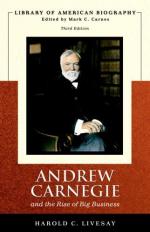
|
| Name: _________________________ | Period: ___________________ |
This test consists of 5 short answer questions, 10 short essay questions, and 1 (of 3) essay topics.
Short Answer Questions
1. Tom Miller is a _________ man who forms joint ventures with Carnegie in several small investments. They form Freedom Iron Company of Lewiston Pennsylvania in 1861 that Carnegie restructures into Freedom Iron and Steel to retool for the Bessemer process in 1866.
2. The mill site is strategically situated _______________ where the Pennsylvania, Baltimore and Ohio railroad and river transportation system is readily available, nearby the coal fields.
3. Americans in the North have how many years of peace and prosperity as they begin to exploit American markets?
4. However, by 1881, a competitor Homestead has the most modern equipment, but is plagued by what problems for two years?
5. Along with Shinn, they put together an effective team based on Carnegie's systematic analysis of personnel to provide performance incentives that raise __________ men through ranks to share ownership.
Short Essay Questions
1. Describe American steel companies between 1870 and 1900.
2. How is Rockefeller involved in Carnegie's business?
3. What is a second dimension necessary to effect this integration?
4. Describe Captain Bill Jones' management of labor.
5. What does the entrepreneurial Carnegie begin in 1872? Describe his work at this time.
6. Carnegie's interest and insistence on cost-cutting leads him into more complex areas of manufacturing detail composition and chemistry. Give an example of this.
7. What does Phipps suggest to Carnegie? How does Carnegie benefit from this?
8. What are the benefits of the Cyclops and Union Mills merger?
9. Describe the firm and the new mill.
10. Who is Homestead? How does Carnegie deal with Homestead?
Essay Topics
Write an essay for ONE of the following topics:
Essay Topic 1
Carnegie forces out all partners but Schwab and brings in "young geniuses" who prove their merit.
Part 1) Describe this forcing out of the partners except Schwab. Why is Schwab kept? How is he unique from the other partners? How might these other partners have felt about being ousted from the company? Should they have been forced out? Why or why not?
Part 2) Why does Carnegie believe that bringing in "young geniuses" is the answer to his problems? How do these "young geniuses" prove their merit? How was this decision to bring in new people beneficial to Carnegie and his company?
Part 3) How has business changed at this time? What other decisions does Carnegie make that reflect this change in the steel business? How are these decisions and actions significant?
Essay Topic 2
A typical pattern in the 19th century is that a community builds up around a few pioneers who leave their homeland and then encourage friends and relatives to join them.
Part 1) How was this the case for the Carnegies? How did they benefit from this? How might this have affected communities in the U.S.?
Part 2) How would this affect one's ability to acclimate to the American culture? What might have been considered American culture at this time? Explain.
Part 3) How are these communities still seen today? Why do these ethnic communities still exist?
Essay Topic 3
With the forming of an enterprise to manufacture Bessemer steel, Carnegie changes from capitalist to entrepreneur.
Part 1) Why does he decide to move into the steel business? How does this change him from a capitalist to an entrepreneur? Is this a good maneuver? If so, why? If not, why not?
Part 2) Carnegie follows a policy of putting all of his eggs in the same basket and watching that basket. Is this a good policy? Why or why not? How has becoming an entrepreneur changed Carnegie? In what ways has he stayed the same?
Part 3) Carnegie's partners include many wealthy executives and merchants. How important are these men in Carnegie's new ventures in steel? How have others been important in Carnegie's professional career? How important are others in your own life and advancements you have made?
|
This section contains 1,215 words (approx. 5 pages at 300 words per page) |

|




